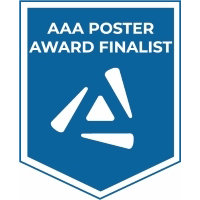Back
ANATOMY
Category: Anatomy
Session: 639 Bones, Cartilage & Teeth
(639.8) Craniofacial Bone Mineral Density at Muscle Attachment Sites in Mice with Osteogenesis Imperfecta
Monday, April 4, 2022
10:15 AM – 12:15 PM
Location: Exhibit/Poster Hall A-B - Pennsylvania Convention Center
Poster Board Number: C145
Introduction: AAA has separate poster presentation times for odd and even posters.
Odd poster #s – 10:15 am – 11:15 am
Even poster #s – 11:15 am – 12:15 pm
Introduction: AAA has separate poster presentation times for odd and even posters.
Odd poster #s – 10:15 am – 11:15 am
Even poster #s – 11:15 am – 12:15 pm
Lauren Murabito (University of Arkansas), Courtney Miller (University of North Texas Health Science Center), Alexandra McBride (Texas Aamp;M College of Dentistry), Jason Organ (Indiana University School of Medicine), Rachel Menegaz (University of North Texas Health Science Center)
Lauren Murabito, Bachelor's of Science
Presenting Author
University of Arkansas
Fayetteville, Arkansas
Presenting Author(s)
Osteogenesis imperfecta (OI) is a genetic disease commonly caused by mutations in the COL1A1 or COL1A2 gene affecting the production of type I collagen, a major component of bone that determines the toughness of bone, or its resistance to fracture. Thus, patients with OI present with brittle bones and higher rates of skeletal fractures. Additionally, defects in the collagen framework of developing bones impair their biomineralization, further compromising bone mechanical properties. Previous work in our lab investigated BMD at cranial locations which experience compressive forces during feeding (e.g. joints). Muscles also contribute to cranial growth through tensile forces exerted on bone during contraction, but the relationship between muscle function and bone quality in OI is unclear. The aim of this study is to quantify the BMD in a mouse model of OI, with a focus on skeletal sites associated with cranial musculature. We hypothesize that the mice with OI will have lower BMD in skeletal areas associated with muscle attachment compared to their unaffected littermates.
To test our hypothesis, we used the homozygous recessive OI murine (OIM) mouse (B6C3Fe a/a-Col1a2oim/J), a model for the severe type III OI seen in humans. Adult (16 weeks old) OIM mice (n=11) and wildtype (WT, n=13) littermates were CT scanned, and BMD was measured using the Bruker CTAnalyzer software in 7 regions of interest encompassing muscle attachment sites on the mandible, zygomatic arch, and parietal bone. For each region, BMD values were compared between genotypes by a Kruskal-Wallis test.
OI mice had significantly lower BMD at the coronoid process (p=0.007), parietal bone (p=0.031), and posterior mylohyoid line (p=0.007) compared to WT mice. No significant differences were found in BMD at the gonial angle or zygomatic arch. This suggests a disproportionate weakness of the temporalis and mylohyoid muscles in mice with OI, but not in the masseter muscle. While type I collagen defects impact the structural organization of skeletal muscle, it is possible that masseter muscle function is preserved in OIM mice because of its key roles in rodent feeding and postural control of the jaw. The imbalance between temporalis and masseter muscles may contribute to the prevalence of dental malocclusions in human patients with type III OI.
The findings of this study support further exploration of specific muscle groups (e.g. jaw adductors/temporalis, hyoid muscles/mylohyoid) and efforts to improve their functions during feeding, as a way of recovering facial growth and preventing dental malocclusions in OI. A better appreciation of muscle-bone interactions in the skull and their effect on bone quality can potentially be used to inform oro-motor therapies to improve feeding function, muscle strength, and facial bone quality for patients with OI.
Support or Funding Information
Funding was provided by the AAA Innovation Program, an Indiana University Collaborative Research Grant, and the Ralph W. and Grace Showalter Trust.
To test our hypothesis, we used the homozygous recessive OI murine (OIM) mouse (B6C3Fe a/a-Col1a2oim/J), a model for the severe type III OI seen in humans. Adult (16 weeks old) OIM mice (n=11) and wildtype (WT, n=13) littermates were CT scanned, and BMD was measured using the Bruker CTAnalyzer software in 7 regions of interest encompassing muscle attachment sites on the mandible, zygomatic arch, and parietal bone. For each region, BMD values were compared between genotypes by a Kruskal-Wallis test.
OI mice had significantly lower BMD at the coronoid process (p=0.007), parietal bone (p=0.031), and posterior mylohyoid line (p=0.007) compared to WT mice. No significant differences were found in BMD at the gonial angle or zygomatic arch. This suggests a disproportionate weakness of the temporalis and mylohyoid muscles in mice with OI, but not in the masseter muscle. While type I collagen defects impact the structural organization of skeletal muscle, it is possible that masseter muscle function is preserved in OIM mice because of its key roles in rodent feeding and postural control of the jaw. The imbalance between temporalis and masseter muscles may contribute to the prevalence of dental malocclusions in human patients with type III OI.
The findings of this study support further exploration of specific muscle groups (e.g. jaw adductors/temporalis, hyoid muscles/mylohyoid) and efforts to improve their functions during feeding, as a way of recovering facial growth and preventing dental malocclusions in OI. A better appreciation of muscle-bone interactions in the skull and their effect on bone quality can potentially be used to inform oro-motor therapies to improve feeding function, muscle strength, and facial bone quality for patients with OI.
Support or Funding Information
Funding was provided by the AAA Innovation Program, an Indiana University Collaborative Research Grant, and the Ralph W. and Grace Showalter Trust.

